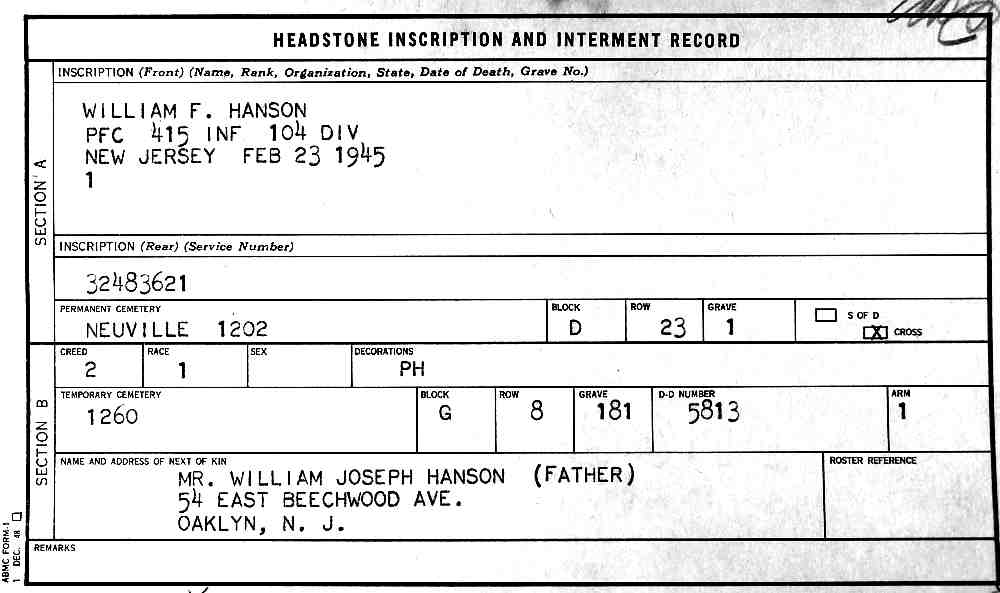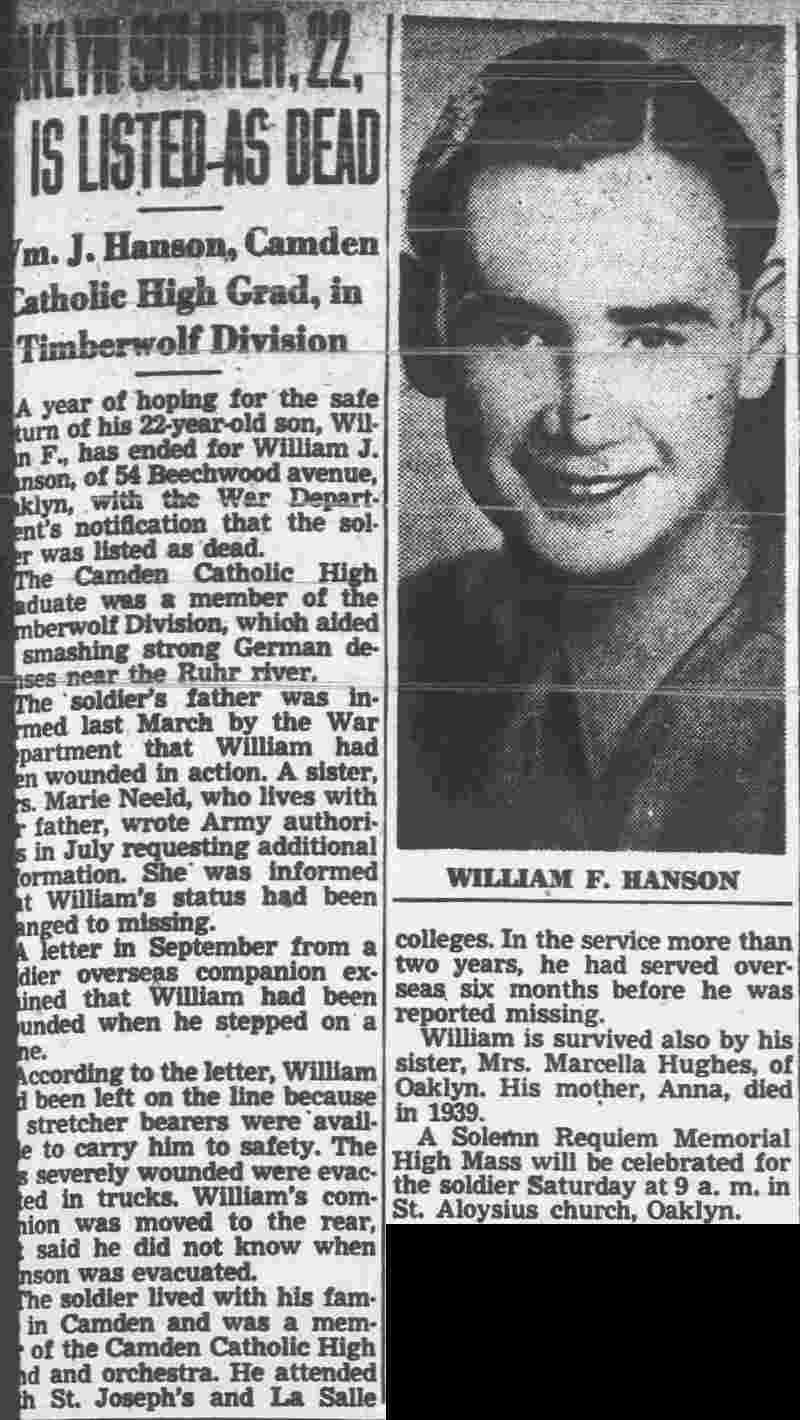|
PRIVATE FIST
CLASS WILLIAM F. HANSON was born in 1920. He was the son of William J.
and Anna Hanson. He grew up in Oaklyn, New Jersey with his parents and
sister Anna. William F. Hanson attended Camden Catholic High School and
St. Joseph's and LaSalle colleges before being nducted into the Army on
December 7, 1942.
William
F. Hanson went overseas in 1944 with the 415th Infantry Regiment, 104th
Infantry Division.
The 104th Infantry
Division landed in France on September 7, 1944
and moved into a defensive position in the vicinity of
Wuustwezel,
Belgium, October 23, 1944. There it relieved the British 49th Division
and joined the First British Corps, First Canadian Army. This relief
made the 413th Infantry the
first Regiment of the Division to take its place in line, the first
regiment of the American Army to relieve an allied unit on the Western
Front, as well as the first American Regiment to fight under the command
of an Allied Army on this front. The 104th went
over to the offensive on the 25th, soon liberating
Zundert,
Holland, gaining control of the Breda-Roosendall Road, and
overrunning the Vaart Canal defenses.
Leur
and Etten fell as the Division advanced in a coordinated drive to the
Mark
River at Standdarbuiten on November 2, 1944 and
established a bridgehead. Zevenbergen was
captured and the Maas River reached November 5. The bulk of the Division
moved near Aachen,
Germany to relieve the First Division; join
the U.S. Seventh Corps, First U.S. Army, with some elements remaining
to secure Moerdijk,
Holland until November 7. Our job in Holland was over. We recovered our
wounded, buried our dead and moved on to our enemy's homeland.
On
November 16, 1944 the 104th attacked, (for details, see
Operation
Queen) taking Stolberg and
pushing on against heavy resistance.
Eschweiler fell
on the 21st and the enemy was cleared from the area west of the Inde
River, including Inden,
by December 2. Lucherberg was
held against enemy counterattacks on December 3, and all strongholds
west of the Roer
(Ruhr) River were captured by the 23rd. The 104th actively
defended its sector near duren and
Merken
from December 15, 1944 to February 23, 1945, and moved across the
Roer,
taking part in
Operation
Grenade).
When the 104th
crossed the Roer (Rur) River on 23
February 23, 1945, it was were not alone. The German's "Ardenes Offensive" had only delayed
the inevitable and with that interruption contained, the Allies were anxious to continue
their drive to end the war in Europe. Several plans had been under study, causing renewed
lively debate among Allied commanders. But on
February 2, at a meeting on the Mediterranean island of Malta, the Combined Chiefs of Staff
of the United States and Great Britain approved the specifics of Supreme Commander
Eisenhower's plan for a drive to the Rhine; a staggered attack starting at the north to be
joined step by step to the south.
The plan was for a major offensive to be put into effect and to start with Field Marshal Sir
Bernard L. Montgomery's Twenty-first Army Group, at the northern end of the front facing
Germany. With his Canadian First Army and British Second Army, Montgomery's Operation
Veritable was set to start the attack on 8 February. Two days later
(Feb 10), an operation code-named Grenade was to start with the U.S. Ninth Army commanded by
Lt. General William H. Simpson. The Ninth Army, under command of Montgomery's Twenty-first
Army since the Battle of the Bulge, was to cross the Roer and linkup with the Canadians
coming from the Nijmegen area of Holland. Coverage of the right flank of the Ninth Army was
assigned to the VII Corps of the U.S. First Army commanded by Maj Gen J. Lawton Collins
& on loan from First Army for this task. Following Operation Grenade was to be General
Omar Bradley's Twelfth Army Group, the center of the front facing Germany, in an operation
named Lumberjack. But Bradley wasn't to move until Montgomery reached the Rhine, with this
move scheduled to begin on
February 23. Next in line was the Sixth Army Group, on the south end of the line, commanded
by Lt. General Jacob L. Devers, and it was to remain on the defensive until Bradley reached
the Rhine. Code-named Undertone, this operation was set to begin on 15 March.
A key to crossing the Roer River was control of the major dams upstream from the assault
divisions and responsibility for reaching them was with General Bradley's XII Army Group.
The dams had been constructed to control flooding of the Roer and both the Americans and
Germans recognized their importance. After a much tougher battle than anticipated, the dams
were not reached until
February 9, and unfortunately only after the retreating Germans had opened the flood gates.
Operation Veritable, of the British & Canadian Armies, had moved as scheduled at 5 AM, 8
February, after 5 1/2 hours of artillery fire from 1050 guns, firing 500,000 shells on their
6 mile front. But the rapidly rising waters of the Roer forced a delay of the Ninth Army's
Operation Grenade. Once the vast storage of water was released from the locks of the dams,
the once peaceful Roer flooded its banks. At the north, making matters worse for the
Canadians, the retreating Germans had dynamited the areas dikes and by the second day of the
attack, hundreds of men were stranded by swiftly rising floodwaters. At the south end of the
line, the water from the largest Roer dam, the Schwammenauel, rushed out after the Germans
destroyed the power-room machinery and the discharge valves, making it impossible to halt
the flow of water. Operation Grenade would have to wait. Rising in depth by as much as 5',
the worst effect of the flood was to increase the current sharply, at some points to more
than 10 miles per hour. Along most of its banks, the Roer poured over its banks and
inundated the valley floor. Just north of Linnich where the river is normally 25 to 30 yards
wide, it spread into a lake more than a mile wide. More common were areas of 300 to 400
yards across and Grenade was to undergo successive postponements.
Acting on advice of the engineers, Ninth Army's Gen Simpson reset D-day for
February 23, one day before it was calculated that the reservoirs would be drained. By
moving one day early, General Simpson hoped to achieve some measure of surprise. As the
target date for Grenade approached, the accumulated stocks of supplies rose to huge
proportions. In one 5-day period, for example, over 40,000 long tons was received, the
biggest delivery to any army in the theater in a comparable period. Most of it arrived by
rail in more than 6,000 freight cars.
Six infantry divisions were to lead the attack (left to right), 84th & 102th from the
XIII Corps, 29th & 30th from the XIX Corps, and 104th & 8th of the VII Corps. The
XIII & XIX Corps were to represent the main effort with the VII guarding the right
flank. This plan not only gave the VII Corps, protecting the Ninth Army's drive, the deepest
area of penetration, its own right flank was exposed for at least two full days. Methods of
crossing the swollen Roer varied to some extend from division to division. The plans for
some were for only a relatively small force to cross in assault boats with the balance to
use foot-bridges to be constructed as soon as bridgeheads could be secured; a task that
proved easier to plan than execute. The 8th Division planned to make use of motor boats, but
had extreme problems in starting the motors. Some units planned to rely heavily on cable
ferries and amphibious vehicles, while others, including the 104th, relied more heavily on
transporting the attacking companies by assault boats. And while some elected to us smoke
and others didn't, all plans had problems and the mighty Roer took it's toll.
While crossing techniques varied, all divisions relied on a tremendous 45 minute barrage of
artillery supplemented by all available weapons. The 130 battalions of field artillery and
tank destroyers assigned in support of the Ninth Army & VII Corps, totaling more than
2,000 guns, was one of the heaviest artillery concentrations of the war, providing one
artillery piece for each 10 yards of front (the weight of the artillery projectiles that the
XIX Corps alone could throw at the enemy in six days of combat on a two division front was a
massive 8,138 tons). Adding to the fire power of artillery plus antiaircraft guns, tanks,
tank destroyers, chemical mortars, and all other infantry weapons, each corps had an armored
division attached. Also formidable air support was provided (in direct support of the Ninth
Army was the XXIX Tactical Air Command, employing five groups of fighter-bombers, 375
planes, and one tactical reconnaissance group) and in spite of the difficult of the
rampaging Roer, by nightfall, nearly 25,000 American infantrymen were across. On the second
day, the water level had dropped enough to permit the construction of 19 bridges, 7 of them
vehicular, allowing tanks to join the attack (in case bridge construction was delayed, 500
C-47 transport aircraft, fully loaded with supplies, sat ready for air-drops). Plagued by an
open right flank, the 8th Division had the roughest D-day of all and on 25 February, its
commander, Maj Gen Wm G Weaver suffered the fourth in a series of heart attacks & was
evacuated & relieved by Brig Gen Bryant E Moore, assistant division commander of the
104th. Enemy opposition was stubborn, but on 27 February VII Corps completed its role in
Operation Grenade, covering 13 miles from the Roer at Duren to the Erft River & Canal to
seal the Ninth Army's south flank. It's drive was to continued, but now the VIII Corps
belonged to another operation that General Bradley planned to carry his 12th Army Group to
the Rhine.
Operation Grenade was a tremendous success, but not with out great cost. The Ninth Army
(with a strength of 303,243) reported 92 KIA, 61 MIA, 913 WIA for a total of 1,066
casualties and VII Corps (with 75,00 men) suffered 66 KIA, 35 MIA, 280 WIA for a total of
381.
Private
First Class Hanson was killed on the first day of Operation Grenade. He
was severely wounded after stepping on a land mine. Private First Class
Hanson was not able to be evacuated, and apparently died of his wounds
on the battlefield. His family was notified that he had been wounded
March of 1945, however, for a year there was no news as to his
whereabouts or circumstances. In July of 1945 the Army changed his
status to missing. His body was located months later and in March of
1946 the Army notified his family that he had died. William F. Hanson
was buried at the Ardennes Cemetery in Neupre, Belgium.
|

